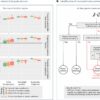Harmful algal blooms (HABs) are phytoplankton colonies that may harm aquatic ecosystem and human health. The fish die-offs, shellfish closures and reluctance among consumers to eat seafood often caused by these blooms costs the U.S. an average of $4.6 billion annually.
A new study involving Florida Tech shows that a novel machine-learning approach using global climatic patterns can improve seasonal prediction of HABs. This improvement could mean more time for policymakers to consider and adopt proper planning and mitigation strategies, such as restrictions in harvesting, and help in monitoring toxins in shellfish to keep contaminated products off the market, the researchers report.
“Improved seasonal prediction of harmful algal blooms using large-scale climate indices,” published today in the journal Communications Earth and Environment, found that inputting global climatic patterns into a machine learning-based framework improved seasonal prediction of HABs over Lake Erie. The researchers also found that the use of climatic pattern data allowed the improved seasonal prediction to be completed earlier than usual.
“Any progress in the understanding and prediction of HABs can make a significant impact in the U.S. and around the world,” said Pallav Ray, a meteorologist and associate professor in ocean engineering and marine sciences at Florida Tech and a co-author of the study.
Conventionally, HAB prediction is conducted using information about chemicals from industries and agricultural land that are transported into bodies of water through runoff. However, HAB predictions that use this chemical data as the main driver have been found to be less accurate during extreme bloom years. The new research found that when a set of climatic patterns was used in a novel machine learning approach along with that chemical data, HAB prediction accuracy over Lake Erie improved dramatically.
A growing number of water bodies, including the Indian River Lagoon, are severely affected by excessive nutrient loading. Lake Erie is impacted at its watershed due to the presence of large manufacturing facilities and extensive agricultural lands. This has led to increasingly large and deep blooms over the past decades.
The study also found that the large-scale ocean-atmosphere structures are distinctly different during mild HAB years compared to severe HAB years, suggesting the influence of large-scale circulation on the seasonal evolution of HABs over Lake Erie.
“These results are expected to help extend the lead time and improve the seasonal prediction of HABs not only in Lake Erie but also in other water bodies around the world where chemical data may not be available,” Ray said.
Lead author Mukul Tewari, an atmospheric scientist at the IBM Thomas J. Watson Research Center in Yorktown Heights, New York, said the research also highlights the importance and value of having a varied research team. “Any significant progress in HABs prediction requires interdisciplinary collaboration among experts in HABs, climate science, machine learning, and computational and data sciences,” he said.
More information:
Mukul Tewari et al, Improved seasonal prediction of harmful algal blooms in Lake Erie using large-scale climate indices, Communications Earth & Environment (2022). DOI: 10.1038/s43247-022-00510-w
Provided by
Florida Institute of Technology
Citation:
Machine learning using climatic pattern data may help predict harmful algal blooms earlier (2022, September 1)



